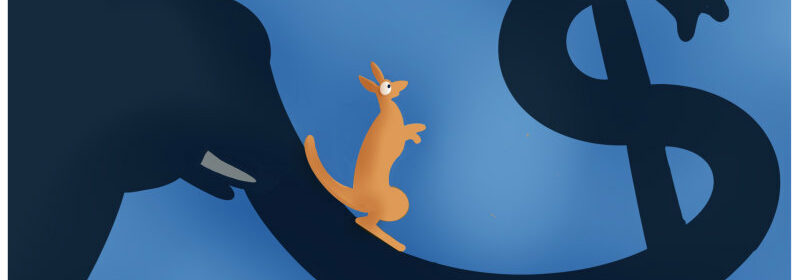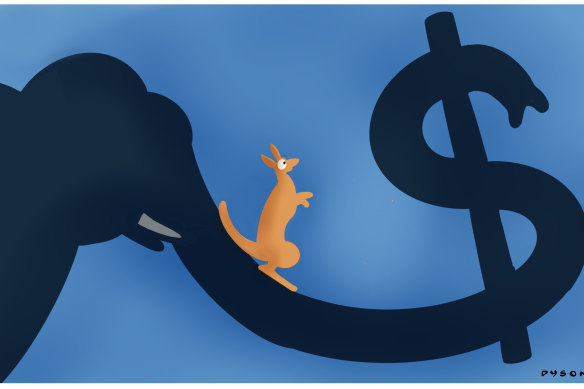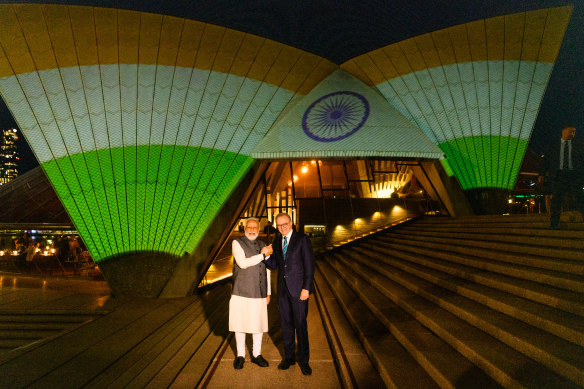India’s booming and that’s excellent news for Australia

Save articles for later
Add articles to your saved list and come back to them any time.
The veteran international economist Ken Courtis was describing the inevitable slowing of China’s growth as its economy matured. “But Australia has India,” he told me, “so you’ll be fine for the next 30 years.”
I thought he was just being glib. Four years on and the Canadian-born, Asia-based dealmaker is looking prescient. China has faded, India boomed. It is showing signs of becoming the “next China”, economically speaking.
Illustration by Andrew Dyson.Credit:
India’s scale and standing in the world have been upgraded as China’s have been downgraded. China was long the world’s most populous country. In April, the United Nations announced that this title had passed to India.
China, for decades, was the world’s fastest-growing major economy. India has taken that title in the last few years. And is expected to consolidate that claim as the lean Indian elephant outpaces the bulkier Chinese dragon.
“This will be India’s century,” says Ketan Patel, founder of London investment firm Greater Pacific Capital and a former managing director of Goldman Sachs investment banking.
And as the democratic world has become more wary of China’s drive to dominance, it has elevated India as a potential counterweight.
Narendra Modi and Anthony Albanese outside the Sydney Opera House on May 24.Credit: James Brickwood
This has worked to Australia’s advantage: “The strategic relationship has developed much more quickly than I expected,” says Peter Varghese, the former head of the Australian Department of Foreign Affairs and Trade and author of Australia’s official India strategy.
“A lot of that has been driven by China. India has been more willing than in the past to engage actively in groups like the Quad [the US, Japan, India and Australia] and other balancing arrangements” against China.
Wine taxes are a metaphor for geopolitical relationships. As Beijing hit Australian wine imports with killer tariffs of between 116 and 218 per cent as part of its effort to break Australian sovereign will, Delhi did the exact opposite.
India cut its tariff on Australian wine from 150 per cent last year to 75 per cent today, thanks to the interim free trade deal instigated by the Morrison government.
Australian negotiators are in Delhi this week haggling over the next phase, a comprehensive free trade agreement. Now the Albanese government aims to get India to cut its wine tariff on Australian tipples to zero, Trade Minister Don Farrell says.
“Both prime ministers are keen on the comprehensive trade deal,” Farrell tells me, “but it’s hard.” They’ve set a deadline for the end of the year.
The two leaders invest energy in the relationship. Leaders are human; small, personal gestures matter. So when Anthony Albanese visited India, he was chuffed to be greeted by a band playing songs from some of his favourite musicians – The Go-Betweens and The Triffids – on the traditional Indian sitar. He reciprocated when he invited Australian cricket greats Steve Waugh and Pat Cummins to meet Narendra Modi at the dinner Albanese hosted for him at the Sydney Opera House. And illuminated the sails with the Indian flag, an image seen by 1.4 billion Indians.
Australia was long seen by India as a second-rate Britain and overlooked accordingly. “What’s changed is that over the last decade, India sensed that Australia had things to offer – that’s new,” Varghese says. “It sees Australia as useful economically, with investment, and geopolitically. And the Indian diaspora is growing so fast” – around three-quarters of a million – “that it’s dragged a lot of Indian attention along with it. The diaspora will play an increasingly important role as a business navigator.”
In 1979, India’s economy was exactly the same size as Australia’s, measured by nominal GDP according to the IMF. Today it is more than twice Australia’s size and its advantage will only lengthen.
Already the world’s fifth-biggest economy, India is projected to overtake Japan and Germany to become number three in five years’ time. Mind you, India’s $US3.7 trillion economy remains small compared with China’s $US19 trillion GDP, which is, in turn, second only to the US.
But the trends have changed. China has hit middle-income status, which inevitably slows growth. And Xi Jinping has aggravated the problem with policy blunders.
Modi, by contrast, has launched India onto a growth trajectory with a few big policy breakthroughs. First the government registered everyone in its IT system: “You don’t have to be literate,” explains Patel. “You turn up in a shack, someone asks you a few questions, takes a thumbprint and a photo and you’re registered.”
So what, you ask? For the first time, everyone could open a bank account, even people with nothing, getting access to debit cards, the digital payments system, and insurance for the first time. Half a billion bank accounts have been opened in the last eight years. These new account holders have deposited $US20 billion.
This, in turn, means that “it’s easier to get a mortgage, to get government subsidies, to get a micro loan, to open bank accounts”, Patel explains. “And now that people have financial inclusion they want digital skills, and digital participation is turning into a revolution.”
Until now, most Indians were in the informal or black market economy. Now, says Patel, “you have 1.4 billion people transacting with each other, all through a costless transaction system where the government bears the cost of making it work”. There is much less bureaucracy in the way of transactions and less corruption, he says.
Together with major investment in physical infrastructure such as rail, there is a major program of investment in digital infrastructure. Incomes are growing, and the consumer economy is thriving. Together with a very healthy demographic structure – half the population is under 30 – India has reached an inflection point.
Modi is proving that good economic policy is good politics. The head of the centre-right think tank Indian Foundation, investment banker Shaurya Doval, says: “The most important reason for Modi’s political success is that people are seeing economic growth come into their own lives. We really think the next 25 years are all about economic growth.”
Yet India, little mentioned in Australian business debates or media coverage, is the elephant in the economic room.
The Opinion newsletter is a weekly wrap of views that will challenge, champion and inform your own. Sign up here.
Most Viewed in World
From our partners
Source: Read Full Article

